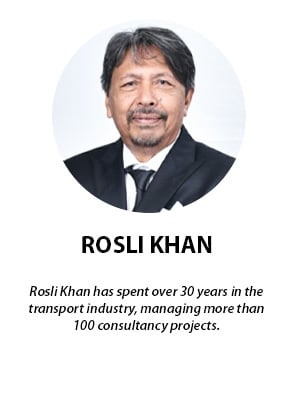
The results of a recent survey showing Loke Siew Fook to be one of our better performing Cabinet ministers may not be far off the mark.
He spoke convincingly at the unity government convention.
Prior to that, Loke had made three brave and impressive policy decisions by –
- doing away with the requirement for a vehicle’s road tax to be displayed on its windscreen
- ending Puspakom’s monopoly by September this year, and
- extending the validity of our driver’s licences from five to 10 years.
He appears decisive and, unlike others, does not engage in policy “flip-flops”. He has clearly made a good start to what is a long journey ahead. What is most important is that he seems to be heading in the right direction.
A broken system
At the beginning of his tenure, Loke took trips on the LRT, presumably out of concern on account of the complaints of poor service on offer and the system’s tendency to break down frequently.
He has tried hard to rectify a broken system that is fast eroding the confidence of public transport users.
LRT breakdowns are just the tip of the iceberg.
It is simply the manifestation of a long-standing problem, namely, the poor state of public transport throughout the country and its impact on urban traffic congestion.
Lack of planning has deprived public transport users the benefit of effective structures and cohesive strategies to manage this important function.
Former prime minister Dr Mahathir Mohamed should take the lion’s share of the blame here. His penchant for cars has resulted in skewed policies involving more toll highways rather than comprehensive public transport infrastructure.
Subsequent administrations also failed to develop policy strategies to increase public transport usage. Instead, national policies have always been biased towards cars.
Steps on how to improve the transportation network have always been driven by car usage, leading to more highways, more roadbuilding, more parking spaces, better car access and cheaper interest rates to encourage car ownership.
The cherry on the cake for car owners has been the hefty petrol subsidies enjoyed over the years.
Inherited problems
As a result, this unity government has inherited a myriad of car-centric policies which it must either undo or rigorously reform.
There are also various fundamental problems associated with public transport, with far too many entities involved – KTMB, MRT, LRT, the monorail, the KLIA aerotrain and airlines services, especially those operating between Peninsular Malaysia, Sabah and Sarawak – all of which are owned by the finance ministry (MoF).
With the transport ministry’s (MoT) role limited to supervising these entities, much of the decision-making falls back on the MoF.
The core problem lies in the way previous administrations structured the agencies responsible for managing public transport services.
The reality is that, in the current environment, structures inherited from Mahathir’s and Najib’s eras are no longer workable.
Both administrations limited the MoT’s role by placing all public transport functions under MoF or the Prime Minister’s Department.
This big split between ownership and supervision has become a cause for great concern.
It has resulted in a complex, inefficient, inept and wasteful organisational structure comprising six different agencies – KTMB (for KTM train services), Prasarana (LRT), MRT Corp (MRT), Malaysian Rail Link (East Coast Rail Link or ECRL), APAD (formerly SPAD) and what is left of the road vehicles licensing board (which now only operates in Sabah and Sarawak).
Structural defect
KTMB, Prasarana, MRT Corp and the Malaysian Rail Link are all owned by the MoF, while the last two are bit-part regulators established under the MoT.
Railway services have been split even further between train operator KTMB, which falls under the MoF, and the Railway Assets Corporation (RAC), which is owned by the MoT.
RAC owns all the stations, land, tracks, signals, and power lines, and is supposed to undertake all maintenance work involved.
To further complicate matters, a separate railway authority has been set up specifically for the ECRL.
Another one, MyHSR, owned by MoF, was set up to run the now abandoned high-speed rail services to Singapore.
Meanwhile, the supervising authority for public transport is parked under the public land transport agency (APAD).
However, APAD, formerly the public land transport commission (SPAD), has now been reduced to a unit under the road transport department (JPJ), which also falls under the purview of the MoT.
APAD is the unit which is supposed to supervise, monitor and approve all rail services and systems in the country, but is that even possible?
Indeed, it would be a tall order for APAD to supervise the giant rail corporations owned by MoF effectively.
One wonders if reforms are in the pipeline. - FMT
The views expressed are those of the writer and do not necessarily reflect those of MMKtT.



No comments:
Post a Comment
Note: Only a member of this blog may post a comment.